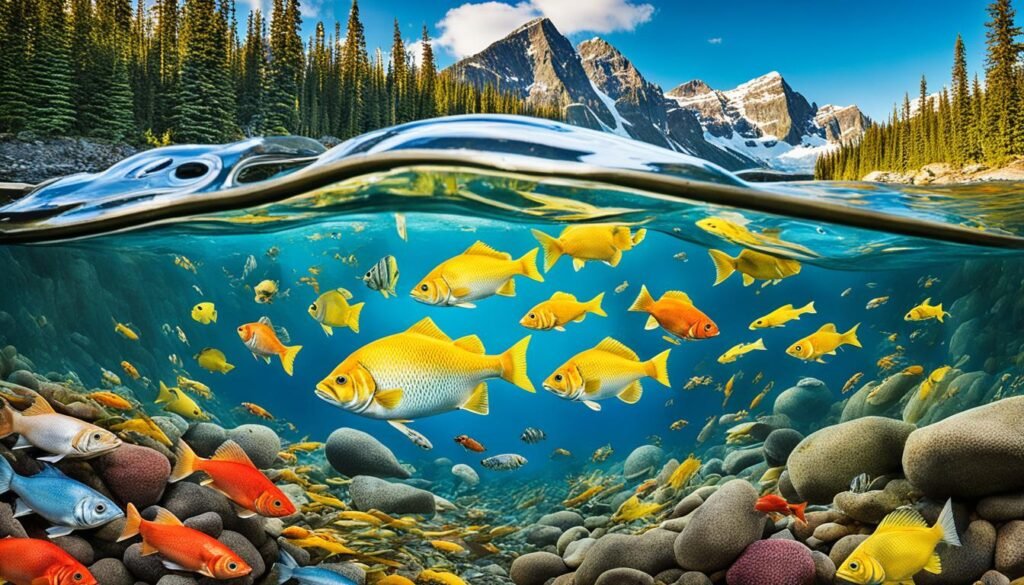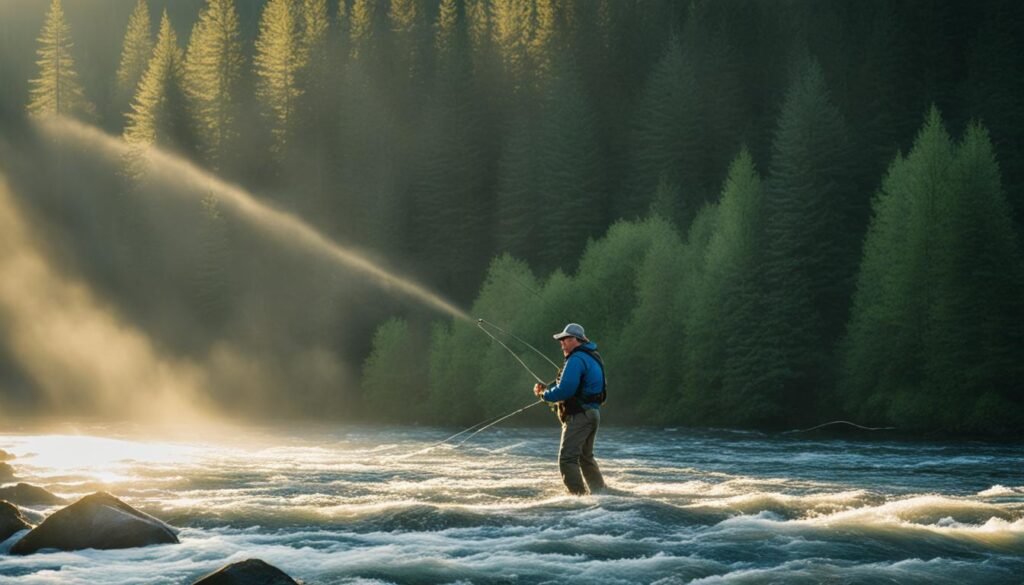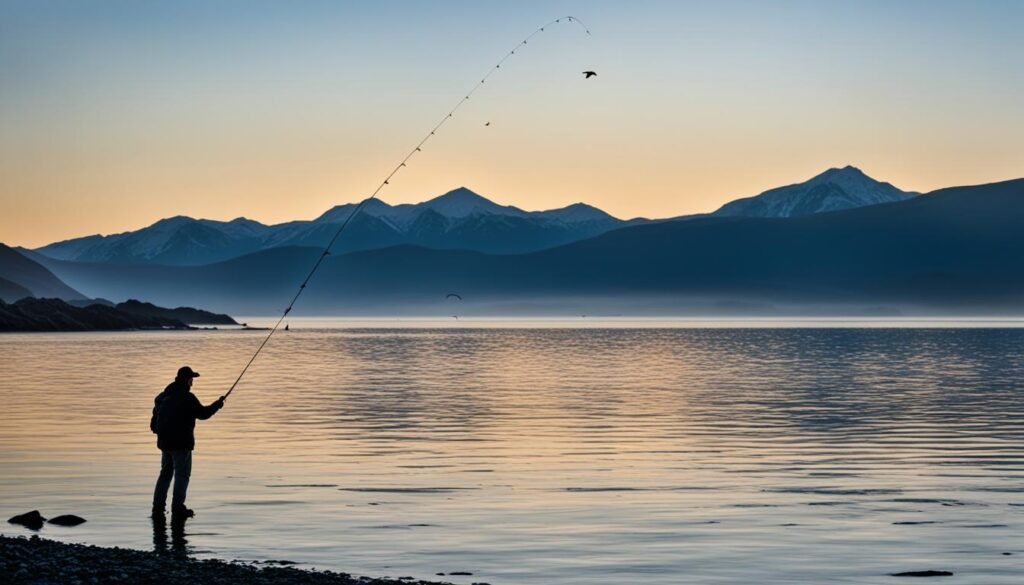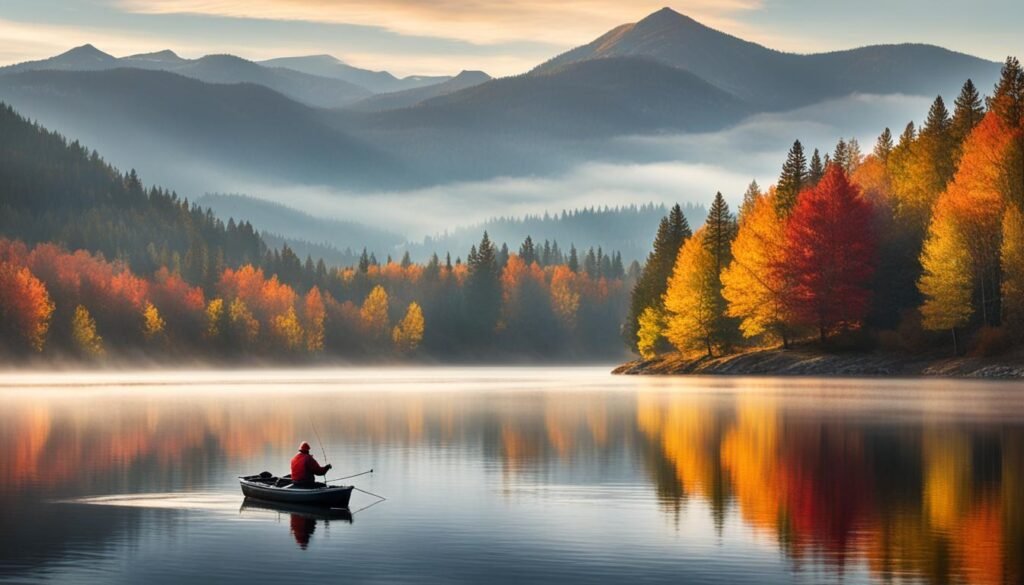Have you pondered the best time for fishing in Canada?
With its vast waters and fish species, Canada offers unmatched angling opportunities. From rugged Pacific coasts to serene lakes and rivers, each region and season holds fishing secrets.
No matter your experience level, knowing top fishing spots and seasons can elevate your Canadian adventures. Picture reeling in massive Chinook salmon or battling feisty walleye – this fishing guide reveals prime times for your favourites.
Key Takeaways about Best Times to Fish in Canada
- Canada boasts over 150,000 miles of coastline, providing ample opportunities for saltwater and freshwater fishing.
- Six different salmon species can be found across Canada, each with its unique characteristics and peak seasons.
- Spring and summer are generally the most popular times for fishing in Canada, but certain species like lake trout and salmon peak in the fall.
- Detailed fishing calendars outline the availability and quality of catches throughout the year for various species.
- Understanding regional regulations and obtaining proper licenses are crucial for responsible and legal fishing practices.
👉 Immerse yourself in Canada’s diverse waterways and discover the thrill of the catch.
Introduction to Fishing in Canada
Canada offers anglers diverse fishing opportunities. From mountain streams to oceans, rural and urban lakes, there’s variety. With endless waters and species, enthusiasts explore diverse experiences.
Affiliate Disclaimer: We may earn a commission from purchases made through the links on this page without any addiitonal costs for you. Thank you for supporting our website ! Appreciated 👍
Canada’s Vast Fishing Opportunities
Spanning six time zones, Canada boasts waters and species variety. From rugged coastlines to pristine interior lakes and rivers, there’s no shortage of diverse opportunities. Both freshwater and saltwater enthusiasts find abundance.
Diverse Waters and Species
Canadian fishing offers remarkable experiences for all skill levels. Whether seeking trophy catches or tranquil settings, the waters cater to preferences. The diversity is impressive.
Anglers pursue freshwater like trout, bass, walleye, muskie, salmon, and saltwater species like halibut, tuna, cod. Glacial Rocky Mountain streams, Atlantic salmon rivers – the range astounds.
| Province/Territory | Notable Fishing Destinations | Target Species |
|---|---|---|
| Ontario | Lake Ontario | Pike, Walleye, Bass, Chinook Salmon, Brown Trout |
| British Columbia | Cowichan River | Trout (various species) |
| Alberta | Bow River | Brown Trout, Rainbow Trout |
| Saskatchewan | Last Mountain Lake | Walleye |
| Manitoba | Lake Dauphin | Walleye, Northern Pike |
| Quebec | Saguenay | Walleye, Perch |
| Prince Edward Island | North Lake | Bluefin Tuna |
| Nova Scotia | Bras d’Or Lake | Brook Trout, Brown Trout, Rainbow Trout, Cod, Herring, Striped Bass |
| Newfoundland and Labrador | Gander River | Atlantic Salmon |
With diverse opportunities, waters and species, Canada offers unparalleled angling. It’s a must-visit for enthusiasts worldwide.
Top Catches in Canada

Canada offers anglers a remarkable variety of freshwater fish to target. Swift-swimming trout, hard-fighting bass, and elusive muskellunge abound.
Freshwater Favorites
Trout fishing enthusiasts find haven in Canada’s pristine waters. Rainbow, Cutthroat, Steelhead, Brook, and Lake Trout thrive here. British Columbia boasts exceptional trout fisheries.
Bass fishing draws many anglers to Nova Scotia, New Brunswick, and southern Ontario. Largemouth and Smallmouth Bass provide unforgettable experiences from shore or boat.
Trout, Bass, and Walleye
The walleye, abundant across Canada, is highly sought-after. Anglers target these elusive, tasty fish in Lake of the Woods, Rainy Lake, Detroit River, Lake Erie, St. Lawrence River, and Bay of Quinte.
Muskellunge (Musky)
For the ultimate challenge, muskellunge fishing in southern Ontario and Quebec beckons. These powerful predators in Lake Huron, Georgian Bay, Ottawa River, and St. Lawrence River offer explosive strikes and incredible strength.
| Fish Species | Key Locations | Notes |
|---|---|---|
| Trout | British Columbia | Rainbow, Cutthroat, Steelhead, Brook, and Lake Trout |
| Bass | Nova Scotia, New Brunswick, Southern Ontario | Largemouth and Smallmouth Bass |
| Walleye | Lake of the Woods, Rainy Lake, Detroit River, Lake Erie, St. Lawrence River, Bay of Quinte | Abundant across Canada |
| Muskellunge (Musky) | Southern Ontario, Quebec, Lake Huron, Georgian Bay, Ottawa River, St. Lawrence River | Challenging trophy fish |
Salmon Fishing in Canada

Canada offers anglers world-class salmon fishing opportunities. Six different species thrive across the nation’s waters. From the mighty Chinook to the acrobatic Coho, these salmon provide intense battles.
The prized Chinook, or King salmon, is the largest Pacific salmon species. These powerful fish attract anglers. In Campbell River, British Columbia, July to August is prime Chinook season.
Coho, Sockeye, and Pink Salmon
British Columbia hosts other Pacific salmon: Coho, Sockeye, and Pink. The spirited Coho is a favorite. Its peak season in Campbell River is September. Sockeye and Pink salmon also run through the region.
Chum and Atlantic Salmon
The Chum salmon arrives in British Columbia waters during summer months, peaking August-September. On the East Coast, Atlantic salmon attract fly anglers with their strength and agility. Techniques like trolling, mooching, and fly fishing target Canada’s iconic salmon species.
| Salmon Species | Peak Season in Campbell River, BC | Key Locations |
|---|---|---|
| Chinook (King) | July – August | Campbell River, Vancouver Island, Fraser River |
| Coho (Silver) | September | Campbell River, Ucluelet, Sooke, Terrace |
| Pink | August – September | Campbell River, Gulf Islands |
| Chum | August – September | Campbell River, Gulf Islands |
| Atlantic | Summer | East Coast Rivers and Streams |
Saltwater Fishing Opportunities

Canada’s coastlines offer unparalleled saltwater fishing opportunities. The Pacific and Atlantic oceans invite anglers. They can explore diverse marine environments teeming with life.
Rockfish and Lingcod
The waters off British Columbia’s coast are home to 36 rockfish species. Anglers have a wide variety of targets. Lingcod fishing is equally enticing.
These formidable predators can reach 130 pounds. They are a prized catch in the Pacific.
Halibut
The Atlantic Coast is renowned for halibut fishing. These flatfish grow to immense proportions. In British Columbia, the largest halibut caught weighed 459 pounds.
This is a testament to the region’s world-class fishery.
Tuna and Other Saltwater Species
Offshore, the chase for tuna is exhilarating for anglers. Bluefin and albacore tuna provide heart-pounding action. They put an angler’s skills to the test.
Beyond tuna, Canada’s coastal waters offer cod, flounder, seabass, crab, and shrimp. This ensures a true feast from the sea.
| Species | Location | Peak Season |
|---|---|---|
| Rockfish | Pacific Coast | Spring to Fall |
| Lingcod | Pacific Coast | Spring to Fall |
| Halibut | Atlantic and Pacific Coasts | Summer (Peak in August) |
| Bluefin Tuna | Atlantic Coast | Summer to Fall |
| Albacore Tuna | Pacific Coast | Summer to Fall |
Best Times to Fish in Canada

One great thing about fishing in Canada is the many fish you can catch. With lots of lakes and rivers, anglers have prime fishing all year.
Spring and summer are popular fishing times. As it gets warmer, fish feed more aggressively. This is ideal for catching bass, walleye, and trout in freshwater. You can also target saltwater rockfish and lingcod.
Fall Fishing Opportunities
Fall fishing in Canada is also excellent. When water cools, fish like lake trout spawn. You can catch iconic salmon during their runs. The colorful fall scenery makes it truly special.
Winter Ice Fishing
For a unique adventure, try ice fishing. When lakes freeze, anglers drill holes to fish below the ice. Popular catches include pike, perch, and trout. With proper gear and safety, ice fishing is exhilarating.
| Month | Average Low Temperature | Average High Temperature | Rainy Days | Notable Fishing |
|---|---|---|---|---|
| June | 50°F (10°C) | 77°F (25°C) | 16 days | Guests can catch over 100 fish in a day |
| July | 53°F (12°C) | 81°F (27°C) | 19 days | Excellent summer fishing conditions |
| September | 47°F (8°C) | 70°F (21°C) | 19 days | Fall fishing for salmon and trout |
Salmon Fishing Seasons in Canada
Timing your fishing adventure is crucial for success. The Canada salmon seasons vary by species and region.
In British Columbia, Chinook salmon arrive first, typically from May to September. Peak season is July and August.
Coho salmon follows, ideal from August to October. Peak season is September.
Sockeye, Pink, and Chum salmon grace the waters in August and September.
On the East Coast, Atlantic salmon run peaks in summer.
Salmon fishing regulations can vary annually, so check current regulations and consult experts.
Campbell River offers opportunities for Chinook, Coho, Pink, and Chum salmon fishing. Reputable charter companies provide guided excursions.
- Chinook salmon: May to September.
- Coho salmon: July to September.
- Pink and Chum: August and September.
Campbell River boasts scenic surroundings for hiking, museums, and exploring nature.
| Salmon Species | Peak Season | Size Range |
|---|---|---|
| Chinook (King) | July – August | 10 – 30+ lbs |
| Coho (Silver) | September | 4 – 12 lbs |
| Sockeye | August | 4 – 8 lbs |
| Pink | July – September (odd years) | 3 – 6 lbs |
| Chum | August – September | 8 – 15 lbs |
Fishing Regulations in Canada
Recreational fishing in Canada has regulations. The Canadian fishing regulations ensure sustainable practices and ecosystem protection.
Federal and Provincial Regulations
Fisheries and Oceans Canada (DFO) manages most marine species. Provincial governments oversee freshwater species.
Provincial laws cater to regional ecosystems. Federal rules maintain coastal resource consistency.
Licensing and Permits
Anglers need a fishing license. Requirements vary by province, water body, and species.
Some regions need special permits. Anglers must know catch limits, fishing periods, gear restrictions.
Following Canadian fishing regulations ensures sustainable aquatic resources for future generations.
Planning a Fishing Trip to Canada
Canada offers vast wilderness areas. Planning a fishing trip requires consideration of lodging, outfitters, and transportation. Many renowned fishing lodges provide guided services, accommodations, and access to prime fishing spots. Reputable outfitters can ensure a hassle-free experience.
Lodging and Outfitters
Canada has numerous fishing lodges for anglers. Options range from rustic cabins to luxurious resorts. Many lodges offer all-inclusive packages.
Partnering with experienced outfitters is invaluable. They assist with permits, licenses, transportation, gear rentals, and accessing remote fishing hotspots.
| Lodge | Location | Highlights |
|---|---|---|
| Eagle Nook Resort | Ontario | Fly-in access to pristine lakes, guided fishing trips, cabin accommodations |
| Nimmo Bay Resort | British Columbia | Luxury wilderness resort, heli-fishing, salmon and halibut fishing |
| Compass West Outfitters | Alberta | Experienced guides, fly fishing trips, remote wilderness access |
Transportation and Access
Transportation is crucial for accessing remote fishing destinations. Outfitters arrange options like float planes, helicopters, or boats. For accessible locations, driving or trains can work.
Exploring backcountry waterways by canoe or kayak offers adventure and solitude. Hiring guides simplifies logistics for a safe, memorable paddling experience.
“The joy of fishing isn’t just catching, but the journey itself – breathtaking landscapes, nature’s serenity, and camaraderie. Canada’s wilderness is an angler’s paradise.” – Experienced Canadian Angler
Tips for Fishing in Canada
Preparing for a fishing adventure in Canada’s vast waters ensures success. From selecting the right fishing gear for Canada to understanding weather conditions, following these tips helps anglers.
Gear and Tackle Preparation
Equip your boat with stainless steel props and skeg guards. These prevent damage from submerged rocks, common in Canadian waterways.
Carry a well-stocked tackle box with lures, baits, and tackle for target species. For saltwater fishing, use corrosion-resistant gear.
Navigation and Maps
Obtain detailed lake maps and navigational aids for safe, effective navigating Canadian waters. Canada’s lakes and rivers are vast and remote.
GPS devices, depth finders, and marine charts help locate prime fishing spots, navigate channels, and avoid hazards.
Weather and Conditions
Canada’s diverse geography means rapidly changing weather conditions. In spring and fall, temperatures fluctuate from warm to chilly.
Dress in layers and bring appropriate rain gear. Be aware of extended daylight hours during summer, affecting fish behavior.
| Season | Temperature Range | Considerations |
|---|---|---|
| Early (May-June) | Over 25°C to 10°C | Highly variable weather, dress in layers |
| Mid (July-August) | Hot summer days | More predictable conditions, peak fishing |
| Late (September) | Below 10°C to over 20°C | Cooler temps, ideal for certain species |
Encountering wildlife is possible in Canada’s rugged wilderness. Take necessary precautions and be aware of surroundings.
Conclusion
From towering Rocky Mountain peaks to Atlantic and Pacific rugged shores, Canada offers unforgettable fishing. Diverse freshwater and saltwater opportunities exist for all skill levels.
Iconic catches like trout, salmon, bass, and halibut await in pristine waters. Explore and revel in the thrill of each catch.
Understand prime seasons, follow regulations, and plan your adventure meticulously. Cast lines in remote mountain streams or battle offshore giants.
Canada’s natural bounty promises unforgettable angling. Appreciate the rich fishing heritage and abundant waterways.
Gather gear, secure licenses, immerse yourself in world-class Canadian fishing opportunities. From vibrant Pacific salmon runs to elusive eastern lake muskies, adventure awaits.
FAQ about Best Times to Fish in Canada
What are the best times to fish in Canada?
Spring and summer are popular fishing times. The warm weather makes casting pleasant.
Most fish species actively feed during these seasons. However, some peak in fall, like lake trout and salmon, with cooler waters.
Winter offers unique ice fishing opportunities. Target species like pike, perch, and trout through frozen lakes and rivers.
What are the top freshwater species to target in Canada?
Canadian freshwater fishing is renowned for trout. This includes rainbow, cutthroat, steelhead, brook, and lake trout.
Bass (largemouth and smallmouth), walleye, and muskellunge offer anglers thrilling experiences with their tough-fighting spirit.
What salmon species can be found in Canada?
Salmon fishing in Canada is exceptional, with six different species available.
The prized Chinook (King) salmon can exceed 100 pounds. The acrobatic Coho (Silver) salmon is known for intense battles.
Sockeye, Pink, and Chum salmon inhabit British Columbia waters. Atlantic salmon are favorites for fly anglers on the East Coast.
What saltwater species can be caught in Canadian waters?
Canada’s coastlines offer incredible saltwater fishing. In the Pacific, target rockfish species and lingcod.
The Atlantic Coast is renowned for massive halibut. Bluefin and albacore tuna provide offshore excitement.
Other popular catches include cod, flounder, seabass, crab, and shrimp.
When is the best time for salmon fishing in Canada?
Salmon fishing seasons vary by species and location in Canada.
In British Columbia, there’s a sequence: Chinook, Coho, Sockeye, Pink, and Chum.
On the East Coast, Atlantic salmon run peaks in summer. Time trips for preferred species’ peak seasons.
What regulations govern fishing in Canada?
Recreational fishing in Canada is jointly regulated by federal, provincial, and territorial governments.
The federal government manages marine species. Freshwater species fall under provincial and territorial jurisdiction.
Obtain valid licenses and follow regulations like catch limits, seasons, and gear restrictions.
What should I consider when planning a fishing trip to Canada?
Consider lodging and outfitters when planning a Canadian fishing trip.
Many fishing lodges offer guided services, accommodations, and access to prime spots.
Transportation options like seaplanes and boats provide access to remote areas.
How should I prepare for fishing in Canada?
Equip outboards with stainless steel props and skeg guards to prevent rock damage.
Obtain detailed lake maps and navigational aids for safe and effective navigation.
Be prepared for rapidly changing weather, long daylight hours, and potential wildlife encounters.
Source Links
- https://airtunilik.com/en/when-is-the-best-time-to-fish-in-northern-canada/
- https://fishingbooker.com/blog/best-fishing-canada/
- https://ganglers.com/how-weather-affects-fishing-in-canada-what-to-know/
- https://northernwilds.com/whats-great-fishing-canada/
- https://absolutesportfishing.ca/best-month-to-salmon-fishing-in-bc-campbell-river/
- https://www.fodors.com/community/canada/best-time-of-year-and-place-for-salmon-fishing-909710/
- https://www.arcticlodges.com/when-is-the-best-time-to-fish-in-northern-canada/





